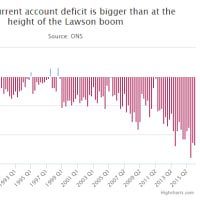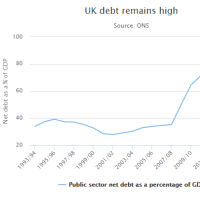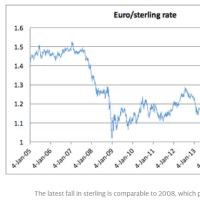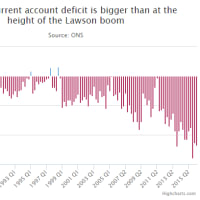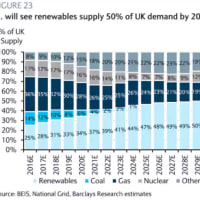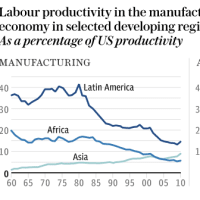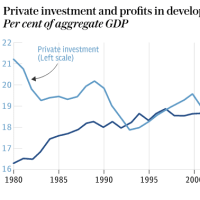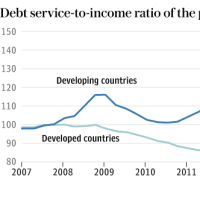Oil industry on borrowed time as switch to gas and solar accelerates
(ガス太陽光への切り替え加速で、石油業界はロスタイム突入)
By Ambrose Evans-Pritchard
Telegraph: 6:41PM BST 20 Aug 2014




(ガス太陽光への切り替え加速で、石油業界はロスタイム突入)
By Ambrose Evans-Pritchard
Telegraph: 6:41PM BST 20 Aug 2014
There may be little point battling icebergs to drill in the Arctic, or in trying to extract oil from the ultra-deepwater fields in the mid-Atlantic, beneath layers of salt, three kilometres into the Earth
北極圏で氷山と闘いながら掘削するのも、大西洋の真ん中で岩塩層を3キロも掘って超深海油田を狙おうとするのも、殆ど無意味かもしれません。
The props beneath the global oil industry are slowly decaying. The big traded energy companies resemble the telecom giants of the late 1990s, heavily leveraged to a business model already threatened by fast-moving technology.
世界の石油産業の支柱はゆっくりと腐りつつあります。
大手エネルギー企業はまるで1990年代終盤の電話通信大手です。
急速に変化するテクノロジーに既に脅かされているビジネス・モデルに思い切りテコ入れしています。
Citigroup warns - or cheerfully acclaims, depending on your point of view - that world energy markets are entering a period of "extreme flux", with oil caught in triple encirclement by cheap natural gas, much more efficient vehicles and breathtaking advances in solar power as scientists crack the secrets.
世界のエネルギー市場は、石油業界が科学者の秘密解明による安価な天然ガス、超エコ・カー、太陽光発電の大発展という三重苦に囚われる「究極の変動」期に突入しつつある、とシティグループは警告(または、見方によってはご機嫌に称賛)しています。
The combined effect is to "bend" to the curve of global oil use over coming years, eroding the assumptions that have underpinned a threefold rise in Western oil industry debt to $600bn since 2005, much of it to hunt for crude in prohibitively expensive places. Costs rose 9pc in 2012 and 11pc last year, according to the US Energy Department.
この複合効果は今後長期に亘って世界の石油消費曲線を「曲げ」、西側の石油産業の債務を2005年以降に6,000億ドルへと3倍に増やす根拠となった前提を崩していくでしょう(その大半は恐ろしく金のかかる場所で原油を探すため)。
米エネルギー省によれば、そのコストは2012年に9%、昨年は11%上昇したとのことです。
There may be little point battling icebergs to drill in the Arctic, or in trying to extract oil from the ultra-deepwater fields in the mid-Atlantic, beneath layers of salt, three kilometres into the Earth.
北極圏で氷山と闘いながら掘削するのも、大西洋の真ん中で岩塩層を3キロも掘って超深海油田を狙おうとするのも、殆ど無意味かもしれません。
The "oil intensity" of global GDP has already halved since 1980s. We are becoming more frugal. Gasoline demand in the OECD rich states has been sliding in absolute terms since 2007, punctuated by ups and downs, but dropping overall from 15.5m barrels a day (b/d) of crude to 14m b/d.
「石油集中型」の世界のGDPは1980年代以降、既に半減しています。
僕らはどんどん質素になっています。
OECDのガソリン需要は絶対値にして2007年以降減り続けていて、時折増減はありますが、全体的には1日1,550万バレルから1,400万バレルまで減少しました。
Citigroup's report - "Energy 2020: The Revolution Will Not Be Televised" - says the average efficiency of new cars in the US has risen by 4.6 miles per gallon (mpg) since 2008 under fuel economy mandates. It is still rising at a steeper rate. Gasoline demand will slide by 900,000 b/d in the US alone by 2020.
シティグループがまとめた『エネルギー2020年:革命は放送禁止』によれば、燃費基準により、米国の新車の燃費は2008年比平均+4.6マイルになったそうです。
これは今も急速に改善されつつあります。
米国だけでも、ガソリン需要は2020年までに1日90万バレル減少すると思われます。
China has even more draconian curbs coming into force, with a 50mpg fuel economy mandate by 2020. Its output of electric cars is up 177pc in a year, and hybrids are up 567pc. India will reach 50mpg by 2021, Mexico by 2025.
中国はもっと厳しい削減を推し進めており、2020年までに50マイル/ガロン達成を掲げています。
電気自動車の生産台数は一年間で+177%、ハイブリッドカーは+567%となりました。
インドも2021年までに、メキシコも2025年までに50マイル/ガロンを達成するでしょう。
Crude prices have decoupled from the global commodity nexus for the past three years, held up by the Arab Spring and disruptions in Africa. This split-level energy market is becoming untenable.
原油価格はこの3年間に、アラブの春とアフリカの混乱に足をとられて、国際商品市況からデカップルしてしまいました。
このように分裂したエネルギー市場は持続不可能になりつつあります。
The US shale revolution has caused natural gas prices in North America to collapse. With a long delay, and by convoluted means, this effect is spreading to Asia, where liquefied natural gas (LNG) prices have halved this year.
米国のシェール革命により、北米の天然ガス価格は暴落しました。
長いタイムラグを経て複雑な形で、この影響はアジアにまで広がり、現地では今年に入ってLNGの価格が半分に値下がりしました。
In the end, oil must converge towards gas prices since vehicles can be designed to use either source, or both. The new Cummins Westport ISX 12G gas engine released last year competes directly with diesel. Natural gas lorries are expected to take around 4pc of the US market this year as new taxes and pollution laws come to bear.
自動車はいずれか、もしくは両方を利用するように作れるのですから、石油価格はいずれはガス価格に収束しなければならないのです。
昨年発売されたCummins Wesport ISX 12Gガス自動車はディーゼルと正面から競争しています。
新しい税金と汚染規制法が施行される今年、米市場の天然ガス・トラックの割合は4%程度になるだろうと予想されています。
"We think a large portion of the freight market could utilise LNG and penetration rates could ultimately top 40pc," said Citigroup.
「輸送市場の大半はLNGを利用出来るだろうと考える。浸透率はいずれ40%を超えるかもしれない」とシティグループは言っています。
Navigant Research says the global gas fleet will reach 1.9m lorries and 1.8m buses by 2022. The switch to gas is spreading to pick-up trucks and passenger vehicles as the technology gets cheaper. The gas option for the new bi-fuel Chevrolet Silverado has fallen to $9,500. Even railroads are dipping their toes in the water. CSX is testing a hybrid that can run on natural gas or diesel.
ナヴィガント・リサーチによれば、世界のガス自動車は2022年までにトラックは190万台、バスは180万台に達するだろうとのこと。
テクノロジーが安価になるにつれて、ガスへの切り替えはピックアップ・トラックや乗用車で広がりつつあります。
新しいシボレー・シルバラード・バイフューエルのガス燃料型の価格は9,500ドルまで下落しました。
鉄道までもがこの動きを試しつつあります。
CSXは天然ガスでもディーゼルでも走行可能なハイブリッド列車を試験中です。
It is possible that gas and LNG prices will converge upwards, rather than oil coming down. That seems unlikely. America's gas ouptut has risen from 440 to 720bn cubic metres (bcm) in six years - 20pc of global production - and is still rising. The US Energy Department expects it to reach 960bcm by the end of the decade. These are huge volumes.
石油価格が下落するのではなく、ガスとLNGの価格が上昇して収束するということはあり得ます。
余りその可能性はなさそうですが。
米国のガス生産量は6年間で4,400BCMから7,200BCM(世界の生産量の20%)まで増加しましたが、未だ、増え続けています。
米エネルギー省は2020年までに9,600BCMに達するだろうと予測しています。
これは莫大な量です。
The Marcellus Region in Pennsylvania has multiplied output seven-fold in four years, with an accelerating surge over the past year as drilling technology gets better.
ペンシルバニアのマーセラス地区の生産量は4年間で7倍に増加し、掘削技術が改善される中で、昨年は急激な伸びを示しました。
There is now speculation that the US will surpass Qatar to become the world's top exporter of LNG by 2020. Australia is catching up - albeit at high cost - and it too is expected to triple LNG exports and overtake Qatar by 2020.
今や、米国は2020年までにカタールを追い抜いて、世界最大のLNG輸出国になるのではないかと憶測されています。
オーストラリアも(高コストにも拘らず)米国の後を追っており、やはり2020年までにLNGの輸出量を3倍に増やしてカタールを追い抜くだろうと予想されています。
Even if global gas fails to deliver as expected, this will merely accelerate the powerful shift towards solar power already under way, eroding the demand for oil more slowly by a different means.
ガスの動きが予想を裏切ったとしても、これは既に進行中の力強い太陽光シフトを加速して、石油需要を他の方法でよりゆっくりと侵食するだけでしょう。
Citigroup said solar already competes in the growing regions of the world on "pure economics" without subsidies. It has reached grid parity with residential electricity prices in Germany, Italy, Spain, Portugal, Australia and the US southwest. Japan will cross this year, Korea in 2018. It forecast that even Britain will achieve grid parity by 2020, a remarkable thought for this wet isle at 51 or 52 degrees latitude.
シティグループは、太陽光は既に世界中の益々広い地域で補助もなく「純粋に経済性」で競争しているとしています。
ドイツ、イタリア、スペイン、ポルトガル、オーストラリア、米国南西部では住宅向けの電気料金のグリッド・パリティを達成しました。
日本では今年、韓国は2018年に達成されるでしょう。
同行は英国ですら2020年までにグリッド・パリティを達成するだろうと予想していますが、緯度51-52°の雨がちな島国では驚くべきことです。
The industry can at last tap a "large investor universe" through the market for asset-backed securities. It priced debt below 5pc last year. Some US electric companies are starting to build solar farms for hard-headed commercial reasons as a hedge against future shifts in the gas price. This is astonishing.
この業界は遂にABS市場を通じて「巨大な投資家ユニバース」にアクセス出来るようになりました。
昨年の借入金利は5%以下でした。
今後のガス価格の変動に対するヘッジという現実的な商売上の理由により、米国の電気会社の一部は太陽光発電ファームの建設を開始しています。
これは驚くべきことです。
Roughly 29pc of all electricity capacity added in America last year came from solar. The story is by now well-known. A McKinsey study found that installed solar power in the US across all sectors has dropped from $6 a watt to $2.59 in four years, largely due to the collapse in the cost of solar cells.
昨年は、米国の発電容量の約29%が太陽光でした。
この話は今では有名です。
マッキンゼーのリサーチによって、
明らかになりました
主に太陽光パネルの大幅な下落により、全米全セクターの1ワット当たりの太陽光発電コストは4年間で6ドルから2.59ドルまで下落しています。
The next leap in competitiveness will come from falling "soft costs", currently 64pc of the residential solar price in America. This happened in Germany as scale built up, and is following in the US. In California you can sign up for solar panels in a supermarket, with no money down, and make a saving from day one.
次は、米国の住宅向け太陽光電力料金の64%を占めている「ソフト・コスト」の下落によって競争力が大きく伸びることでしょう。
これはドイツでスケールが大きくなるにつれて起こったことですが、米国がこれに続いています。
カリフォルニア州では、スーパーで前金も払わずに太陽光パネルを契約出来る上に、1日目から節約が出来ます。
The clinching shift will come when the battery storage is cheap enough and lasts long enough for users to draw down their suplus generated during the day to cover needs at night, opening the way for mass exodus from the grid, unless utilities harness it first to their own advantage.
決定的なシフトは、利用者が日中発電した電気の余りを夜間のニーズに回せるようになるほどバッテリーが十分に安くなって十分に長持ちするようになった時に起こるでしょう。
そうなれば、電力会社が先にこれを自らのアドバンテージのために利用しない限り、グリッドからの大量流出への道が切り開かれることになります。
There are at least 220 research projects into energy storage currently under way in the US, many funded by the US Advanced Research Projects Agency and other arms of the world's scientific superpower. It is Hegel's irony of history. We can now see that the oil price shock of 2008 was traumatic enough to draw an emergency response, bringing forward oil's nemesis.
現在、米国ではエネルギー貯蔵に関する研究プロジェクトが少なくとも220件進行中であり、その多くは米高等研究計画局やその他、世界に名立たる科学機関の後援を受けています。
これはヘーゲル的な歴史の皮肉です。
2008年の石油ショックは緊急対応を招いて石油業界の宿敵の成長を早めるほどのトラウマだったということも、今ではわかります。
Harvard is working on an organic flow battery using quinones - from rhubarb - instead of rare earth metals. It hopes to cut battery costs by two-thirds within three years. Rivals at the University of Southern California think they can eventually slash the cost by 90pc below today's lithium-ion batteries.
ハーバード大学は稀少土類ではなく(ルバーブの)キノンを利用した有機フロー電池の研究を行っています。
3年以内に電池のコストを3分の2削減することを期待しています。
南カリフォルニア大学のライバルは、最終的には現在のリチウム電池より90%もコストを削減出来るだろうと考えています。
It is a fair bet that scientists will have conquered intermittency by the end of the decade, at which point the switch to renewables becomes a stampede. This is where great fortunes may be made, perhaps the mirror image of the wealth to be lost on fossil defaults.
科学者が2020年までに間欠性を克服することは考えられないことではなく、その時点で、再生可能エネルギーへの怒涛のシフトが起こるでしょう。
こここそ大儲けが期待出来そうなところであり、化石燃料系のデフォルトで大金が失われるのと対照的な光景となるでしょう。
Brokers Sanford Bernstein call it the new order of "global energy deflation". Technology momentum is unstoppable, and one-way only.
サンフォード・バーンスタインはこれを「世界エネルギー・デフレ」の新秩序と呼んでいます。
テクノロジーの勢いは止められないものであり、しかも一方通行なのです。
Big Oil is trapped, gradually running down legacy reserves. The longer that geopolitical eruptions disguise this erosion of competitiveness by propping up prices, the more emphatic the shift to renewables. Yet if prices do drift down to $80 - as many expect - they will lose money on their exotic ventures.
ビッグ・オイルは雁字搦めになり、徐々に資産を食い潰していくことでしょう。
地政学的混乱が価格を支えることでこのような競争力の低下を誤魔化す期間が長引けば長引くほど、再生可能エネルギーへのシフトの激しさは増すことでしょう。
しかし、多くの人が予測しているように、80ドルまで値下がりすれば、化石燃料業界は自らの大冒険につぎ込んだ金をなくすことになるのです。
The energy group Douglas-Westwood says half the oil industry needs prices of $120 or more to generate free cash flow under current drilling plans and shareholder dividends. Leverage may catch up with them, a risk flagged recently by Standard & Poor's.
エネルギー・グループのダグラス・ウェストウッドによれば、石油業界の半分は、現在の開発計画と配当計画を支えるキャッシュフローを実現するには、1バレル120ドル以上にならなければいけないそうです。
スタンダード・アンド・プアーズは先日、レバレッジに追い付かれるかもしれないリスクについて警告しました。
The oil-exporting states are also trapped. Russia needs crude prices near $110 to balance the budget. Natixis says the fiscal break-even cost for Iraq is $108, for Saudi Arabia $97 and the Emirates $89. Bahrain and Algeria are over $120.
石油輸出国も雁字搦めです。
ロシアが財政を均衡させるには、原油価格が1バレル110ドル近くなければなりません。
Natixisは、イラク、サウジアラビア、UEAの場合はそれぞれ108ドル、97ドル、89ドルだとしています。
バーレーンとアルジェリアなら120ドル以上です。
Oil-patronage regimes violate the loose rule that societies with a per capita income above $10,000 become more tolerant, rational and pluralist over time, so we may be doing a favour for these nations if we curb our appetite for oil. Their revolutions may, however, be televised.
石油利権体制は、国民一人あたりの所得が1万ドル以上の社会は時間の経過と共により寛容で合理的で多元的になる、という緩やかなルールを侵害しています。
ですから、僕らが石油嗜好を減らせばこれらの国の役に立つのかもしれません。
とはいえ、彼らの革命は放送されるかもしれません。














